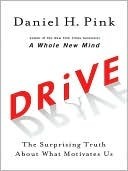More on this book
Community
Kindle Notes & Highlights
Started reading
January 7, 2018
When he conducts job interviews, he tells prospective employees: “If you need me to motivate you, I probably don’t want to hire you.”
Work consists of whatever a body is OBLIGED to do, and that Play consists of whatever a body is not obliged to do.”
Any extrinsic reward should be unexpected and offered only after the task is complete.
But keep in mind one ginormous caveat: Repeated “now that” bonuses can quickly become expected “if-then” entitlements—which can ultimately crater effective performance.
When to Use Rewards: A Simple Flowchart
three innate psychological needs—competence, autonomy, and relatedness.
Human beings have an innate inner drive to be autonomous, self-determined, and connected to one another. And when that drive is liberated, people achieve more and live richer lives.
The three researchers found greater job satisfaction among employees whose bosses offered “autonomy support.” These bosses saw issues from the employee’s point of view, gave meaningful feedback and information, provided ample choice over what to do and how to do it, and encouraged employees to take on new projects.
four aspects of work: what people do, when they do it, how they do it, and whom they do it with. As Atlassian’s experience shows, Type I behavior emerges when people have autonomy over the four T’s: their task, their time, their technique, and their team.
When a call comes in, here’s their job: Serve the customer. No scripts. No monitoring. No timing of calls either. If a call takes one minute, great; if it takes one hour, no problem.
After a job candidate has worked a thirty-day trial period on a team, the prospective teammates vote on whether to hire that person full-time.
anybody who wants to rise in the ranks and lead a team must assemble people willing to work with her.19
encouraging autonomy doesn’t mean discouraging accountability.
Motivation 3.0 begins with a different assumption. It presumes that people want to be accountable—and that making sure they have control over their task, their time, their technique, and their team is the most effective pathway to that destination.
And this distinction leads to the second element of Type I behavior: mastery—the desire to get better and better at something that matters.
He persuaded managers to configure work assignments so that employees had clear objectives and a way to get quick feedback.
One source of frustration in the workplace is the frequent mismatch between what people must do and what people can do.
what people believe shapes what people achieve.
“Being a professional,” Julius Erving once said, “is doing the things you love to do, on the days you don’t feel like doing them.”16
the job. She has found that the single greatest motivator is “making progress in one’s work.”
By creating conditions for people to make progress, shining a light on that progress, recognizing and celebrating progress, organizations can help their own cause and enrich people’s lives.
The first two legs of the Type I tripod, autonomy and mastery, are essential. But for proper balance we need a third leg—purpose, which provides a context for its two mates.
The second group also read stories before hitting the phones, but theirs were from people who had received scholarships from the funds raised and who described how the money had improved their lives.
People at work are thirsting for context, yearning to know that what they do contributes to a larger whole. And a powerful way to provide that context is to spend a little less time telling how and a little more time showing why.
According to The Boston Globe, they believe that “companies can improve their employees’ emotional well-being by shifting some of their budget for charitable giving so that individual employees are given sums to donate, leaving them happier even as the charities of their choice benefit.”
The science shows that the secret to high performance isn’t our biological drive or our reward-and-punishment drive, but our third drive—our deep-seated desire to direct our own lives, to extend and expand our abilities, and to make a contribution.
Now imagine you’re a product manager and your pay is determined by these factors: your sales for the next quarter; your sales in the current year; the company’s revenue and profit in the next two years; levels of satisfaction among your customers; ideas for new products; and evaluations of your coworkers. If you’re smart, you’ll probably try to sell your product, serve your customers, help your teammates, and, well, do good work. When metrics are varied, they’re harder to finagle.
The original Zen of Compensation principles—healthy and fair base salaries; multiple, long-term, hard-to-game metrics; and a congenial work environment—apply here, too.


